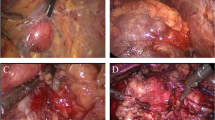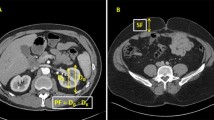Abstract
To investigate the association of adherent perinephric fat (APF) with perioperative outcomes, we conducted a systematic review and meta-analysis of the literature to clarify the impact of APF in patients undergoing partial nephrectomy. A systematic literature search using the Medline, Scopus, and Cochrane databases was performed in April 2019 and updated in November 2019 to identify studies investigating the effect of APF on perioperative outcomes in patients treated with partial nephrectomy with the aim of evaluating its impact on intraoperative, postoperative and oncological outcomes. The Newcastle–Ottawa Scale (NOS) was used to assess the quality of the included studies. A total of 1534 patients in nine nonrandomized, observational studies met our inclusion criteria. Patients with APF were significantly older (p = 0.0001), had a higher BMI (p = 0.0001) and were predominately male (p = 0.003). APF was associated with a higher operative time (p = 0.001) and higher blood loss (p = 0.002). No significant impact of APF was found in terms of postoperative complications, positive margins or length of stay. APF was also found to be associated with malignant renal histology of RCC on final pathology (p = 0.005). APF was associated with some adverse perioperative outcomes, especially a prolonged operating time and higher blood loss. In addition, APF was also associated with underlying renal malignancy, but the precise causal mechanism requires further exploration.






Similar content being viewed by others
References
Escudier B, Porta C, Schmidinger M et al (2019) Renal cell carcinoma: ESMO Clinical Practice Guidelines for diagnosis, treatment and follow-up. Ann Oncol 30:706–720. https://doi.org/10.1093/annonc/mdz056
Ljungberg B, Albiges L, Abu-Ghanem Y et al (2019) European Association of Urology Guidelines on Renal Cell Carcinoma: the 2019 update. EurUrol 75:799–810. https://doi.org/10.1016/j.eururo.2019.02.011
Larcher A, Fossati N, Tian Z et al (2016) Prediction of complications following partial nephrectomy: implications for ablative techniques candidates. EurUrol 69:676–682. https://doi.org/10.1016/j.eururo.2015.07.003
Mari A, Antonelli A, Bertolo R et al (2017) Predictive factors of overall and major postoperative complications after partial nephrectomy: results from a multicenter prospective study (The RECORd 1 project). Eur J Surg Oncol 43:823–830. https://doi.org/10.1016/j.ejso.2016.10.016
Stephenson AJ, Hakimi AA, Snyder ME et al (2004) Complications of radical and partial nephrectomy in a large contemporary cohort. J Urol 171:130–134. https://doi.org/10.1097/01.ju.0000101281.04634.13
Bylund JR, Qiong H, Crispen PL et al (2013) Association of clinical and radiographic features with perinephric “sticky” fat. J Endourol 27:370–373. https://doi.org/10.1089/end.2012.0205
Kawamura N, Saito K, Inoue M et al (2018) Adherent perinephric fat in asian patients: predictors and impact on perioperative outcomes of partial nephrectomy. Urol Int 101:437–442. https://doi.org/10.1159/000494068
Davidiuk AJ, Parker AS, Thomas CS et al (2014) Mayo adhesive probability score: an accurate image-based scoring system to predict adherent perinephric fat in partial nephrectomy. EurUrol 66:1165–1171. https://doi.org/10.1016/j.eururo.2014.08.054
Dariane C, Le Guilchet T, Hurel S et al (2017) Prospective assessment and histological analysis of adherent perinephric fat in partial nephrectomies. Urol Oncol Semin Orig Investig 35:39.e9-39.e17. https://doi.org/10.1016/j.urolonc.2016.09.008
Khene Z, Bensalah K, Largent A et al (2018) Role of quantitative computed tomography texture analysis in the prediction of adherent perinephric fat. World J Urol 36:1635–1642. https://doi.org/10.1007/s00345-018-2292-9
Kocher NJ, Kunchala S, Reynolds C et al (2016) Adherent perinephric fat at minimally invasive partial nephrectomy is associated with adverse peri-operative outcomes and malignant renal histology. BJU Int 117:636–641. https://doi.org/10.1111/bju.13378
Liberati A, Altman DG, Tetzlaff J et al (2009) The PRISMA statement for reporting systematic reviews and meta-analyses of studies that evaluate health care interventions: explanation and elaboration. J ClinEpidemiol 62:e1-34. https://doi.org/10.1016/j.jclinepi.2009.06.006
Wan X, Wang W, Liu J et al (2014) Estimating the sample mean and standard deviation from the sample size, median, range and/or interquartile range. BMC Med Res Methodol 14:135. https://doi.org/10.1186/1471-2288-14-135
Dindo D, Demartines N, Clavien P-A (2004) Classification of surgical complications: a new proposal with evaluation in a cohort of 6336 patients and results of a survey. Ann Surg 240:205–213
Stang A (2010) Critical evaluation of the Newcastle–Ottawa scale for the assessment of the quality of nonrandomized studies in meta-analyses. Eur J Epidemiol 25:603–605. https://doi.org/10.1007/s10654-010-9491-z
Which is more generalizable, powerful and interpretable in meta-analyses, mean difference or standardized mean difference?|BMC Medical Research Methodology | Full Text n.d. https://bmcmedresmethodol.biomedcentral.com/articles/https://doi.org/10.1186/1471-2288-14-30. Accessed 7 Apr2020
Cochrane Handbook for Systematic Reviews of Interventions n.d. /handbook. Accessed 7 Apr 2020
StataCorp. (2013) Stata Statistical Software: Release 13. StataCorp LP n.d, College Station
Ahima RS (2006) Adipose tissue as an endocrine organ. Obesity 14:242S-249S. https://doi.org/10.1038/oby.2006.317
Weisberg SP, McCann D, Desai M et al (2003) Obesity is associated with macrophage accumulation in adipose tissue. J Clin Invest 112:1796–1808. https://doi.org/10.1172/JCI19246
Eckel RH, Grundy SM, Zimmet PZ (2005) The metabolic syndrome. The Lancet 365:1415–1428. https://doi.org/10.1016/S0140-6736(05)66378-7
Grivennikov SI, Karin M (2011) Inflammatory cytokines in cancer: tumour necrosis factor and interleukin 6 take the stage. Ann Rheum Dis 70:i104–i108. https://doi.org/10.1136/ard.2010.140145
Zheng Y, Espiritu P, Hakky T et al (2014) Predicting ease of perinephric fat dissection at time of open partial nephrectomy using preoperative fat density characteristics: preoperative fat characteristics for predicting ease of dissection at OPN. BJU Int 114:872–880. https://doi.org/10.1111/bju.12579
Ishiyama R, Kondo T, Takagi T et al (2018) Impact of the Mayo adhesive probability score on the complexity of robot-assisted partial nephrectomy. J Endourol 32:928–933. https://doi.org/10.1089/end.2017.0779
Borregales LD, Adibi M, Thomas AZ et al (2019) Predicting adherent perinephric fat using preoperative clinical and radiological factors in patients undergoing partial nephrectomy. EurUrol Focus. https://doi.org/10.1016/j.euf.2019.10.007
Morrison A, Polisena J, Husereau D et al (2012) The effect of English-language restriction on systematic review-based meta-analyses: a systematic review of empirical studies. Int J Technol Assess Health Care 28:138–144. https://doi.org/10.1017/S0266462312000086
Acknowledgements
We would like to acknowledge Dr. Naoko Kawamura for responding to our emails and providing us with further information to accurately represent their work included in this meta-analysis.
Author information
Authors and Affiliations
Corresponding author
Ethics declarations
Conflict of interest
No author has any conflict of interest.
Additional information
Publisher's Note
Springer Nature remains neutral with regard to jurisdictional claims in published maps and institutional affiliations.
Supplementary Information
Below is the link to the electronic supplementary material.
About this article
Cite this article
Khene, ZE., Dosin, G., Peyronnet, B. et al. Adherent perinephric fat affects perioperative outcomes after partial nephrectomy: a systematic review and meta-analysis. Int J Clin Oncol 26, 636–646 (2021). https://doi.org/10.1007/s10147-021-01871-6
Received:
Accepted:
Published:
Issue Date:
DOI: https://doi.org/10.1007/s10147-021-01871-6




